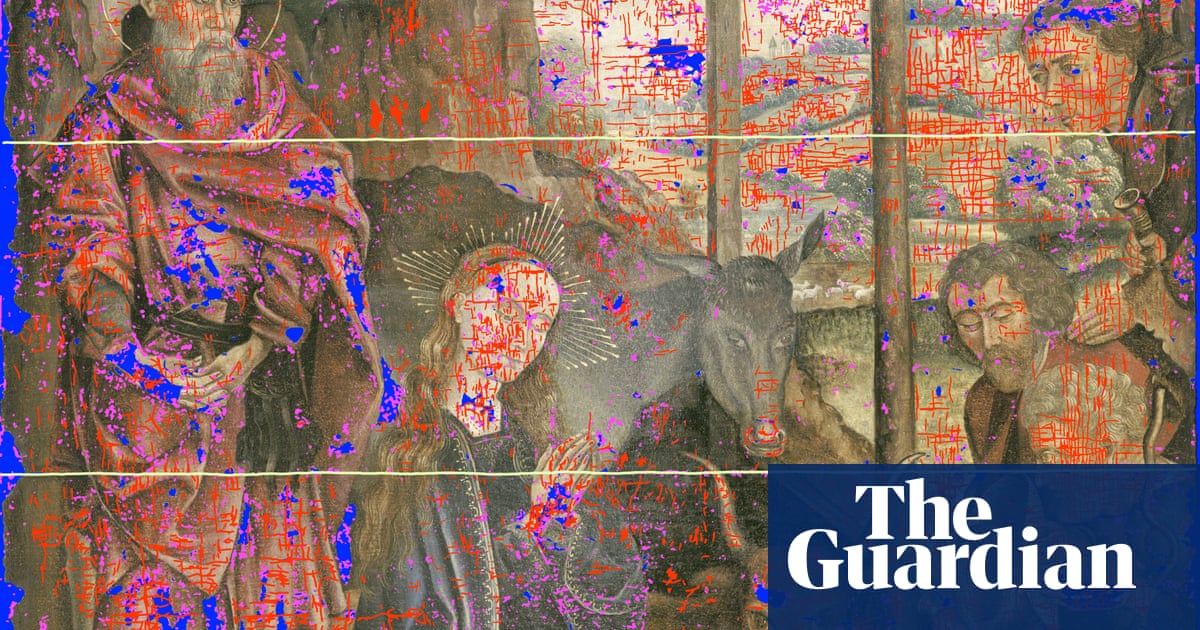The centuries can leave their mark on oil paintings as wear and tear and natural ageing produce cracks, discoloration and patches where pieces of pigment have flaked off.
Repairing the damage can take conservators years, so the effort is reserved for the most valuable works, but a fresh approach promises to transform the process by restoring aged artworks in hours.
The technique draws on artificial intelligence and other computer tools to create a digital reconstruction of the damaged painting. This is then printed on to a transparent polymer sheet that is carefully laid over the work.
To demonstrate the technique, Alex Kachkine, a graduate researcher at Massachusetts Institute of Technology, restored a damaged oil-on-panel work attributed to the Master of the Prado Adoration, a Dutch painter whose name has been lost, as a late 15th-century painting after Martin Schongauer.
The painting is extremely detailed but visibly split into four panels, covered in fine cracks and dotted with thousands of tiny patches where paint has fallen off.
“A lot of the damage is to small, intricate features,” said Kachkine, who estimated it would have taken about 200 hours to restore the painting with traditional conservation techniques. “It has undergone centuries of degradation.”
Kachkine started with a scan of the painting to determine the size, shape and position of the damaged areas. This identified 5,612 separate sections that needed repair.
A digital mask was then constructed in Adobe Photoshop. To restore missing specks of paint, spots were added and colour-matched to surrounding pigments. Damage to patterned areas was corrected by copying similar patterns from elsewhere in the painting. The missing face of an infant was copied from another work by the same artist.
Once finished, the mask was printed on to a polymer sheet, varnished to prevent the ink from running and overlaid on the painting.
In all, 57,314 colours were used to infill damaged areas. The corrections are designed to improve the painting, even if they are not perfectly aligned.
On seeing the result, Kachkine was delighted. “It followed years of effort to try to get the method working,” he said. “There was a fair bit of relief that finally this method was able to reconstruct and stitch together the surviving parts of the painting.”
The approach,described in Nature, can only be used on varnished paintings that are smooth enough for the sheet to lie flat on. The mask can be peeled off or removed using conservators’ solvents, leaving no traces on the original artwork.
Kachkine hopes the method will allow galleries to restore and display scores of damaged paintings that are not deemed valuable enough to warrant traditional restoration.
But he acknowledges there are ethical issues to consider, such as whether having a film covering a painting is acceptable, whether it hampers the viewing experience, and whether particular corrections, such as copied features, are appropriate.
In an accompanying article, Prof Hartmut Kutzke at the University of Oslo’s Museum of Cultural History, said the approach provided a way to restore damaged paintings faster and more cheaply than was possible with conventional techniques.
“The method is likely to be most applicable to paintings of relatively low value that would otherwise be housed behind closed doors, and might not be suitable for famous, valuable artworks,” he said. “However, it could widen public access to art, bringing damaged paintings out of storage and in front of a new audience.”
